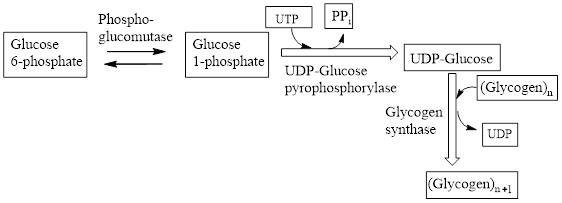
Concept explainers
(a)
Interpretation: To characterize Step 1 in glycogenesis in terms of the type of reaction.
Concept introduction: Glucose is a monosaccharide with the molecular formula
Glycogenesis is the

In the isomerization reaction, a molecule transformed itself to another molecule, having the same number of atoms with a different arrangement.
(b)
Interpretation: To characterize Step 2 in glycogenesis in terms of the type of reaction.
Concept introduction: Glucose is a monosaccharide with the molecular formula
Glycogenesis is the metabolic pathway that converts

In the activation reaction, a high energy-molecule activates another molecule.
(c)
Interpretation: To characterize Step 3 in glycogenesis in terms of the type of reaction.
Concept introduction: Glucose is a monosaccharide with the molecular formula
Glycogenesis is the metabolic pathway that converts

Want to see the full answer?
Check out a sample textbook solution
Chapter 24 Solutions
EBK GENERAL, ORGANIC, AND BIOLOGICAL CH
- give a detailed overview of how tryglycerides are metabolized under aerobic conditions. note the steps involved and the specific reactants and products of each step.arrow_forwarda) Describe the structure of a glycogen molecule. (you can explain without drawing) b) List the three enzymes involved in glycogen degradation and describe the type of reactions they catalyze c) Fill in the numbered blanks in the figure which is the list the source and fates of glucose-6- phosphate. Glycogen pentose phosphate pathway Glucose-6-phosphate Ribose-G-phosphate Glucose glycolysis 3 Amino acida |Lactate Citric acid cyclearrow_forwardIn the table below, choose the appropriate metabolic processes for each scenario: Metabolic Processes Process that Occurs in RBCs Process that Occurs Only in Liver Glycolysis A A Gluconeogenesis B B Beta Oxidation C C Ketogenesis D D Ketolysis E E Urea Formation F F Glyconeogenesis G Garrow_forward
- Define the following terms: (2-3 sentences)1. Metabolism2. Glycolysis3. Beta oxidation4. Chemiosmosis5. Deamination6. Transamination7. Oxidation8. Reductionarrow_forwardDEFINE THE FOLLOWING TERMS: a) Gluconeogenesis b) Glycolysis c) Citric Acid Cycle Please explain this in-detailed and longer, thank you.arrow_forwardIdentify the 4 steps of gluconeoegenesis that are different from glycoslysis. Write the reactants, enzymes, cofactors/coenzymes and products involved in the gluconeogenesis pathway. GLUCONEOGENESIS Reactant Enzymes Coenzyme/ Product Cofactorarrow_forward
- Define the following terms: a. ketogenic amino acid b. glucogenic amino acid c. L-amino acid oxidase d. Krebs urea cycle e. CPSIarrow_forwardWhich of the following answer choices correctly describes the function of amylase? Select one: a. Cleaves polysaccharides into glucose, limit dextrins, and maltose b. Cleaves each molecule of glucose into two molecules of pyruvate c. Cleaves monosaccharides into glucose, limit dextrins, and maltose d. Cleaves polysaccharides into amino acids, limit dextrins, and monosaccharides at alpha-1-6 branch pointsarrow_forwardGlycogen synthesis and glycogen breakdown are catalyzed by separate enzymes. Contrast the reactions in terms of substrate, cofactors (if any), and regulation.arrow_forward
- Indicate whether the following statements are true or false:- a) The pentose phosphate pathway of glucose oxidation can lead to the release of energy. b) NAD + is a coenzyme of transketolase.arrow_forwardExplain the difference between glycolysis, gluconeogenesis, glycogenolysis, and glycogen synthesis. Please note where each one occursarrow_forwardWhich of the following is the third step of glycolysis? Select one: a. Glucose is converted to Glucose-6-phosphate b. Glyceraldehyde-3-phosphate is converted to 1,3 Bisphosphoglycerate c. Dihydroxyacetone (Glycerone Phosphate) is converted to Glyceraldehyde-3-phosphate d. 1,3 Bisphosphoglycerate is converted to 3-phosphoglycerate e. 3-phosphoglycerate is converted 2-phosphoglycerate f. Fructose-1,6 Bisphosphate is converted to Dihydroxyacetone and Glyceraldehyde-3-phosphate g. Glucose-6-phosphate is converted to Fructose-6-phosphate h. 2-phosphoglycerate is converted to Phosphoenolpyruvate i. Phosphoenolpyruvate is converted to pyruvate j. Fructose-6-phosphate is converted to Fructose-1,6,bisphosphatearrow_forward
 Human Anatomy & Physiology (11th Edition)BiologyISBN:9780134580999Author:Elaine N. Marieb, Katja N. HoehnPublisher:PEARSON
Human Anatomy & Physiology (11th Edition)BiologyISBN:9780134580999Author:Elaine N. Marieb, Katja N. HoehnPublisher:PEARSON Biology 2eBiologyISBN:9781947172517Author:Matthew Douglas, Jung Choi, Mary Ann ClarkPublisher:OpenStax
Biology 2eBiologyISBN:9781947172517Author:Matthew Douglas, Jung Choi, Mary Ann ClarkPublisher:OpenStax Anatomy & PhysiologyBiologyISBN:9781259398629Author:McKinley, Michael P., O'loughlin, Valerie Dean, Bidle, Theresa StouterPublisher:Mcgraw Hill Education,
Anatomy & PhysiologyBiologyISBN:9781259398629Author:McKinley, Michael P., O'loughlin, Valerie Dean, Bidle, Theresa StouterPublisher:Mcgraw Hill Education, Molecular Biology of the Cell (Sixth Edition)BiologyISBN:9780815344322Author:Bruce Alberts, Alexander D. Johnson, Julian Lewis, David Morgan, Martin Raff, Keith Roberts, Peter WalterPublisher:W. W. Norton & Company
Molecular Biology of the Cell (Sixth Edition)BiologyISBN:9780815344322Author:Bruce Alberts, Alexander D. Johnson, Julian Lewis, David Morgan, Martin Raff, Keith Roberts, Peter WalterPublisher:W. W. Norton & Company Laboratory Manual For Human Anatomy & PhysiologyBiologyISBN:9781260159363Author:Martin, Terry R., Prentice-craver, CynthiaPublisher:McGraw-Hill Publishing Co.
Laboratory Manual For Human Anatomy & PhysiologyBiologyISBN:9781260159363Author:Martin, Terry R., Prentice-craver, CynthiaPublisher:McGraw-Hill Publishing Co. Inquiry Into Life (16th Edition)BiologyISBN:9781260231700Author:Sylvia S. Mader, Michael WindelspechtPublisher:McGraw Hill Education
Inquiry Into Life (16th Edition)BiologyISBN:9781260231700Author:Sylvia S. Mader, Michael WindelspechtPublisher:McGraw Hill Education





